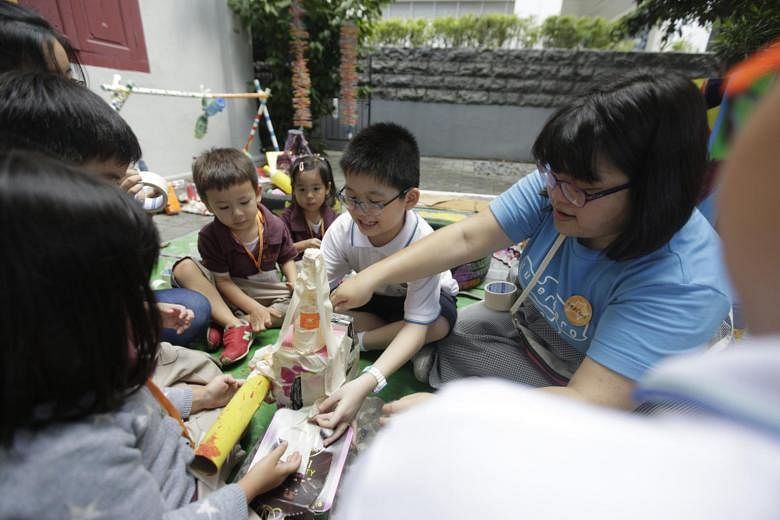It is the school holidays and, at the Enabling Village in Lengkok Bahru, groups of children at an art camp are learning that it is not a bad thing to be different.
Children who might normally disrupt a classroom with loud questions or noises are so curious about group members in wheelchairs that they calm down. Those with cerebral palsy perk up and participate in a theatre workshop or look forward to an outing to the Children's Biennale at National Gallery Singapore.
At lunch break, a curious child might ask why his or her new friend has to be fed Milo through a feeding tube rather than sip it from a packet. A child with autism, over-stimulated, might have a meltdown.
But this is fine. Learning is messy, says Ms Jean Loo of Superhero Me, which is behind this inclusive holiday camp.
Community arts movement Superhero Me aims to give children from low-income households or those with physical or learning challenges access to the arts. A corollary is bringing in those from the so-called normal spectrum, who benefit immensely from socialising with those of different needs.
Ms Loo says creativity is sparked and problem-solving skills honed. And all take pride in achieving something together, whether it is completing a worksheet on paintings or learning to play a musical instrument.
Discussions of art in Singapore are often pegged to ticket prices or ratings controversies. Art is tarred as either expensive or so outrageous that it is elitist and out of the reach of the ordinary person.
What gets lost in such chatter is that art is a marvellous means of fostering understanding, of bringing people together and bridging the differences between them.
Not everyone has the time for a communal arts project, but art offers other ways to learn to share public space with strangers unlike ourselves.
Sensory-friendly shows are on the rise, open to all, but tailored to accommodate those on the autism spectrum. At shows such as these, the audience can usually enter or exit freely. Lights may be brighter as sudden blackouts tend to disturb those with autism.
For example, the Esplanade - Theatres on the Bay's interactive theatre series for children aged two to four, Playtime!, has sensory-friendly performances from Aug 23 to 26. Koko The Great, the tale of a young boy's fantastical adventures in his kampung, allows viewers to exit and enter at will.
A concert by music group Ministry Of Bellz on June 24 includes a pre-show introduction to the performers' handbells to prepare viewers for what they can later expect. Headphones will be provided on request in case a viewer needs a break from the sound.
Organisers of the concert expect a third of the audience will neither have special needs nor be caregivers. Art provides a space to overcome the hesitation or fear someone on the so-called normal spectrum might have when interacting with a person who behaves, looks or learns differently.
Differences in physical or learning abilities seem surmountable through the arts. Some arts-makers are aiming even higher, attempting to bring down more nebulous barriers that keep people apart.
Take next month's O.P.E.N. Kitchens project, part of a public engagement series titled the O.P.E.N. which leads up to the Singapore International Festival of Arts.
Ordinary Singaporeans and Singapore residents who cook at home will share their favourite recipes with those who sign up to visit their kitchens (or a cooking space provided by the festival).
Strangers will be welcome to enter homes that range from a two-room HDB flat to a house with a garden. Visitors can sit on the floor to enjoy a traditional Malay meal - but with vegetarian dishes to cater to different dietary restrictions - or walk through a kitchen garden with a retiree eager to explain the uses of edible plants to the younger generation.
The project's director, artist Noorlinah Mohamed, aims to recreate the spirit of kampung days when neighbours moved freely in and out of one another's homes for a taste of what was cooking in the kitchens and in one another's lives.
Another project, Art As Res Publicae at month's end, brings together people from different walks of life to discuss socially relevant issues such as dementia and the role of art in society.
The idea is to put in the same space people who might have very different thoughts about, say, gender issues and caregiving and work with them to have critical discussions about hot-button topics.
That is what art can do. It can help us enter someone else's space and see how he lives and thinks. Perhaps we might find remarkable similarities between ourselves, perhaps one person's taste is completely unacceptable to another.
The point is to try something different - and to figure out how we can all share the same table.


